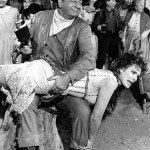I was recently at an appointment in a medical office with my preschool son, Bobby. As he is sometimes want to do, Bobby was wearing a dress. The dress was flowered, with a wide skirt that swirls out when he twirls. He usually wears pants or shorts, but he loves dress-up and has a small collection of dresses of his own, and I figure, if girls can wear pants as well as skirts, why shouldn’t boys be allowed to wear skirts if they so desire? It wasn’t his appointment and we hadn’t been there before, so the woman at the desk naturally assumed Bobby was a girl. I didn’t bother to correct her because it wasn’t a big deal and I saw no reason to embarrass her.
Watching what happened next, though, was fascinating.
Bobby asked for some paper to color. The receptionist rifled through a stack of loose coloring pages, flipping through dozens of Spiderman coloring sheets clearly looking for something, presumably, less masculine. She soon realized that they only had Spiderman sheets left, and paused, looking unsure of what to do. “Spiderman is fine,” I assured her. She pulled a sheet out but still looked concerned.
Then there was the sticker, for of course, every child must have a sticker, and the office had quite a collection—half a dozen rolls of stickers with various themes. The woman zeroed in on the princess roll and reached for it. “Minions,” I interrupted, for I know my son. “Minions.” And so the woman turned to that roll, looking through the different Minion stickers options until she came to the only feminine one—Agnes Gru hugging her pink unicorn. I was playing it cool, but this was a bit much even for me. I lifted my son and let him choose. As I had expected, he wanted a minion, thank you very much, not Agnes Gru. The woman looked surprised, but complied.
Sometimes raising children who don’t always conform to expected gender norms in appearance feels like a sociological experiment—it’s not my kids who are the subject of this experiment, mind you, it’s the adults they encounter. Adults treat children differently based on their perceived gender. Constantly. Anyone who thinks this is an exaggeration should take a small child in public for a while, and then gender swap their clothing and try again. The difference is fascinating.
The day after the above incident we were at another clinic for another appointment. This time I had both of my children with me. They were each wearing boys’ shorts and one of the matching orange shirts they got from school last year. (My older child, Sally, discovered the boys’ section the last time we went clothes shopping and declared the shorts she found there vastly superior to those found in the girls’ section.) Sally’s hair is short—she prefers it that way—and she is often mistaken for a boy when not wearing dresses. She corrects people when is aware of it happening, and tells them there’s “no such thing” as girls’ clothes and boys’ clothes, just clothes.
In any case, when the receptionist at the clinic brought my children each two stickers—to reward them for waiting so patiently while I filled out paperwork—I was not at all surprised to see that all four were superhero stickers. Each sticker featured a collection of male heroes arrayed in bold colors. It seems the receptionist had quite naturally assumed, based on their appearance, that both of my children were boys—and boys get superhero stickers, you see.
The first night, I told my husband the story about Bobby and the receptionist and the coloring pages and stickers. He laughed. We live in a strange, strange world, a world that pretends we’ve somehow achieved equality while continuing to socialize and treat boys and girls very differently. The afternoon of the second day’s appointment, I texted my husband a picture of what the children were wearing and asked him what stickers he thought the receptionist gave them. It wasn’t a hard question for him to answer—boy-appearing children are given boy-coded stickers.
I hear people say girls naturally gravitate toward princess and boys toward superheroes. It’s in their genes, I’m told. What I hear people note less frequently is that we live in a world where girls are given stickers of laughing girls hugging pink stuffed animals and boys are given stickers covered in armored, boldly colored, muscled male warriors in full costume (aka Iron Man, etc.). And it’s not just stickers. It’s everything—from birth. Just as children tend to prefer the diet they’re most familiar with, it makes sense that many children would gravitate toward what they’ve been constantly handed and encouraged to play with, over and over and over again from before they can first remember. (And yes, I’ve seen children actively discouraged from playing with toys associated with the opposite gender.)
On a related note, I recently listened to a TED Radio Hour segment in which Reshma Saujani explained that boys are socialized to take risks while girls are socialized to play it safe. Here is an excerpt from a transcript of the show:
So many women I talk to tell me that they gravitate towards careers in professions that they know they’re going to be great in, that they know they’re going to be perfect in. And it’s no wonder why. Most girls are taught to avoid risk and failure. They’re taught to smile pretty, play it safe, get all A’s.
Boys, on the other hand, are taught to play rough, swing high, crawl to the top of the monkey bars and then just jump off headfirst. And by the time they’re adults – and whether they’re negotiating a raise or even asking someone out on a date, they’re habituated to take risk after risk. They’re rewarded for it. It’s often said, in Silicon Valley, no one even takes you seriously unless you’ve had two failed startups. In other words, we’re raising our girls to be perfect. And we’re raising our boys to be brave. Some people worry about our federal deficit. But I worry about our bravery deficit. Our economy, our society – we’re just losing out because we’re not raising our girls to be brave.
I see this in how people respond to my children. People treat Bobby differently when they think he’s a girl than they do when they think he’s a boy. They’re more careful, more worried, more gentle. When he dresses in boy-coded clothing, in contrast, he’s encouraged to be rough and tumble, and receives praise for jumping from somewhere high (relatively speaking) or getting up quickly after a fall on his kick scooter. (When Bobby wears a dress and gets up quickly after a fall, people’s first reaction is surprise, not praise.) I see it in how adults interact with Sally, too. The messages my children receive from the adults around them vary depending on the clothes they are wearing on a given day.
How my children act, their interests and passions? Those things don’t change. Those things remain the same whether they’re wearing frilly dresses or board shorts. And yet, the perceived gender of their clothing affects how the adults around them treat them in significant ways nonetheless.















